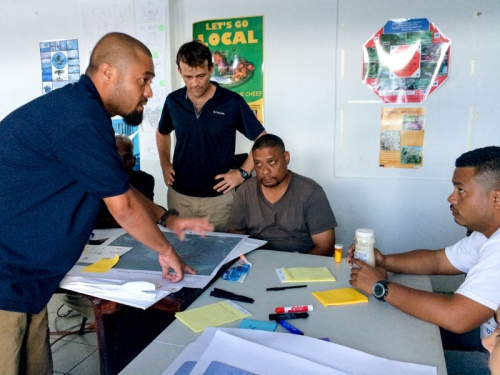In this post Rebecca Weeks discusses her recent paper ‘Using reef fish movement to inform marine reserve design‘. Reproduced from the Journal of Applied Ecology blog. Photo above: Luiz Rocha
The majority of marine protected areas in Pohnpei (Federated States of Micronesia) are too small to protect the species that people care about most. But when livelihoods depend on fishing, establishing large no-take areas is a big challenge.
Overfishing and unsustainable fishing practices are amongst the greatest threats to coral reefs in Micronesia. So from a conservation perspective, it’s easy to say that “bigger is better” when it comes to establishing no-take marine protected areas (MPAs). But at the same time, fishing underpins the livelihoods, food security, and cultural identity of many Micronesians. Many fishers understand the need for marine management, as they see fish populations, and their catch, declining. But they are understandably reluctant to see large no-take areas established, unless they can see a clear benefit of doing so.
Previous conservation planning processes in Pohnpei produced impressive designs on paper, but have fallen short during implementation.Pohnpei’s protected area network achieves the Micronesia Challenge goal to protect 30% of marine and 20% of terrestrial habitats – a feat not matched by many larger, more developed countries. But focusing on achieving international targets for biodiversity conservation has not created local support for protected areas. This support, and subsequent compliance with regulations, is essential if MPAs are to benefit either conservation or fisheries management.

Well designed and effectively managed no-take MPAs can increase fish size and density within their boundaries, and even, in time, boost populations in surrounding areas. However, of the 18 existing MPAs on the reefs surrounding Pohnpei and nearby Ant Atoll, few are working effectively.
Many of the existing MPAs are far too small (5% of MPAs are smaller than 1 km2, 70% are smaller than 5 km2) to protect mobile fish species. Guidelines recommend that to be effective, no-take MPAs must be at least twice the size of the “home range” of species they aim to protect. A home range describes the area in which a fish spends most of it’s time, day to day (eating, sleeping etc.). Provided their entire home range is within an MPA, fish will remain protected. If the MPA is too small, there’s a good chance they will swim out of the safe zone and be caught.

A team of conservation scientists and practitioners from The Nature Conservancy, the Conservation Society of Pohnpei and the Australian Research Council Centre of Excellence for Coral Reef Studies decided that it was time to rethink the design of Pohnpei’s MPAs, to try and improve their adequacy and management effectiveness. This time around, the planning process prioritised local management objectives – i.e. for the fish species that people want to see in the lagoon and on their plates!
We first asked a group of community members, traditional leaders, conservation officers, and representatives from the government, to tell us which fish species mattered most to them. They listed species important for local fisheries (groupers, rabbitfish, parrotfish, surgeonfish, snapper and trevally) and some with cultural and conservation importance (humphead wrasse and bumphead parrotfish).
We then armed them with information on the size of their MPAs, and how far their chosen fish move on a daily basis. Many in the group were experienced fishermen, and were excited to be able to use their own knowledge to help improve the design of their MPAs. All reported back that at present, Pohnpei’s MPAs were too small to protect the species they care about most. Naturally, this led to serious discussion about how the marine protected area network could be improved.
Fast forward 4 months to October 2015, and the designation of the Palikir Pass Marine Sanctuary. Better known as a world class surf break, underneath the waves Palikir Pass is an important site where reef fish aggregate to spawn. Pohnpei’s newest MPA is also the largest (12 km2) on the reefs surrounding the main island of Pohnpei. Though the initial proposal for the MPA covered less than half of this area, fishers saw how they could benefit from a larger no-take closure which would encompass the home ranges of the species they catch, and include more habitats that those species use during their lifetime.
Our open access article describes how using the ecology of locally important coral reef fish species to drive MPA design not only better engaged Micronesian stakeholders in conservation planning, but also influenced decision-makers towards establishing larger MPAs. MPAs which are designed to protect focal species are likely to also benefit many others. In the long term, this is likely to benefit both local fisheries and conservation!
Weeks, R., Green, A. L., Joseph, E., Peterson, N. and Terk, E. (2016), Using reef fish movement to inform marine reserve design. J Appl Ecol. doi:10.1111/1365-2664.12736


One thought on “New Paper: Using reef fish movement to inform marine reserve design”